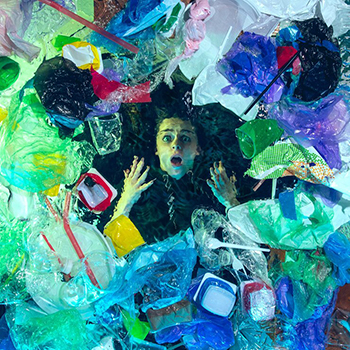
INTRODUCTION
Plastic waste is one of the most pressing environmental challenges of the modern world. Microplastics have found their way into our food chain and even into our blood stream. Every day, billions of plastic containers are used and discarded, leading to increased pressure on our recycling systems. To facilitate the recycling process, plastic products are stamped with recycling codes—numbers inside a triangle that help identify the type of plastic used. Each number, ranging from 1 to 7, refers to a specific type of plastic, and understanding these can make a significant difference in how we manage waste.
TYPES OF PLASTIC
Polyethylene Terephthalate (PETE)

Code 1 : refers to PETE, which is one of the easiest plastics to recycle. It is commonly found in drink bottles such as water, soda, and juice bottles. PETE is also used for salad dressing bottles, peanut butter jars, and some food packaging. Since it is highly recyclable, many curbside recycling programs accept it.
High-Density Polyethylene (HDPE)

Code 2 : represents HDPE, another easily recyclable plastic. Products made from HDPE include milk jugs, detergent bottles, shampoo bottles, and large juice bottles. Due to its strength and resistance to moisture, HDPE is favored for containers that hold liquid products.
Polyvinyl Chloride (PVC)

Code 3 : or PVC, is often found in non-recyclable products such as pipes, shrink wraps, and garden hoses. While useful for various applications like plumbing, PVC is difficult to recycle due to the chemicals used in its production and is generally not accepted in recycling facilities.
Low-Density Polyethylene (LDPE)

Code 4 : refers to LDPE, a more flexible plastic used for plastic bags, bread bags, and frozen food packaging. While LDPE is not commonly recycled through curbside programs, some places accept plastic bags and similar items for recycling at specific drop-off points.
Polypropylene (PP)

Code 5 : denotes PP, a plastic used for straws, bottle caps, yogurt containers, and chip bags. Although polypropylene is durable and heat resistant, it is less commonly accepted by recycling programs, although some do accept it for recycling.
Polystyrene (PS)

Code 6 : or polystyrene, is widely known as the material used to make styrofoam products. This includes disposable coffee cups, plastic food containers, and some packing materials. Polystyrene is not easily recycled and is often disposed of in landfills, contributing to long-term environmental damage.
Other (Polycarbonate or Mixed Plastics)

Code 7 : represents a group of “other” plastics, including polycarbonate and plastics made from a mix of different materials. These plastics are often found in items like sunglasses, DVDs, and electronics cases. Recycling code 7 plastics is generally difficult, and they are not widely accepted by recycling centers.
Conclusion
Recycling plays a crucial role in reducing plastic waste and conserving natural resources. By understanding the different recycling codes and making informed choices, we can help ensure that plastic products are properly sorted and recycled. While some plastics like PETE and HDPE are widely recyclable, others like PVC and polystyrene are more challenging to recycle. Being conscious of the type of plastic used and its recyclability can go a long way in making recycling efforts more effective.
Understanding Plastic Recycling Codes:
What Do the Numbers Mean?
The plastic industry introduced the numerical recycling codes in the 1990s to help recyclers and the general population distinguish between different types of plastics. Each number represents a specific type of plastic and indicates how the material should be recycled. These codes are essential for efficient sorting, recycling, and reprocessing. This guide will walk you through the seven main recycling numbers, their chemical names, and examples of products made from each type of plastic.
THE SEVEN TYPES OF PLASTIC RECYCLING NUMBERS |
||||
| Recycling Code | Plastic Type | Chemical Name | Common Examples | Recyclability |
| 1 | PETE (Polyethylene Terephthalate) | Polyethylene Terephthalate | Water bottles, soda bottles, salad dressing bottles, peanut butter jars, cooking oil bottles | Easily recyclable |
| 2 | HDPE (High-Density Polyethylene) | High-Density Polyethylene | Milk jugs, detergent bottles, juice bottles, yogurt tubs, shampoo bottles | Easily recyclable |
| 3 | PVC (Polyvinyl Chloride) | Polyvinyl Chloride | Plastic pipes, window frames, shrink wrap, garden hoses, cling film | Not widely recycled |
| 4 | LDPE (Low-Density Polyethylene) | Low-Density Polyethylene | Plastic bags, bread bags, frozen food packaging, squeeze bottles | Limited recycling options |
| 5 | PP (Polypropylene) | Polypropylene | Straws, bottle caps, yogurt containers, chip bags, margarine tubs | Recyclable in some programs |
| 6 | PS (Polystyrene) | Polystyrene | Disposable coffee cups, plastic food containers, styrofoam packaging, plastic cutlery | Rarely recyclable |
| 7 | Other (Polycarbonate or Mixed Plastics) | Various (often Polycarbonate) | Sunglasses, DVDs, baby bottles, certain food containers, electronics cases | Difficult to recycle |

